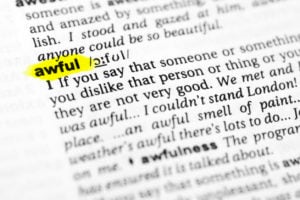Publishing great blog content is an integral part of any inbound marketing strategy. However, even more important than the content itself is the accompanying headline.
Many people fail to see the kind of blog traffic and engagement that they hope for, largely because their headline wasn’t compelling enough to get people to click and read. According to some sources, about eight out of 10 people will read a headline. However, only two out of that 10 will actually read the post. Those are discouraging odds for any blogger, but the good news is those odds can be greatly improved with a more strategic approach to writing headlines.
Next time you’re working on a new blog post, consider using these 5 tricks for writing more clickable blog headlines and increasing reader engagement.
1. Brainstorm multiple headlines.
Before you do anything else, start by brainstorming a list of several potential headlines. Think of different angles from which you can approach the topic, different keywords you can include, and what emotion you’re trying to evoke in your readers.
Write them all down and compare them. Then, choose a couple that you like best and try to find ways to improve or fine-tune them. You will rarely come up with the perfect headline right off the bat, so take some time to play around with it.
Start by working from your broader topic. “Writing better headlines,” for example.
This is the overall theme of our post, but in its current form, it’s a pretty lackluster title for a blog.
A few better headlines might be:
- “How to Write a Better Headline”
- “5 Ways to Write a Better Headline”
- “A Guide to Writing Better Headlines”
Some studies have shown that “number” posts have some of the best engagement from readers, so we’ll go ahead and focus on “5 Ways to Write a Better Headline.”
2. Grab Your Reader’s Attention
A great blog headline should immediately grab your reader’s attention. This can be easily achieved by:
Offering something of value to your audience.
The best way to grab the attention of your readers is to offer them something that they want. Tell them what it is you plan to teach them or what solution you can provide to their problems. If they have nothing to gain by reading your post, why should they bother reading it at all?
- Using exciting language and interesting adjectives. Use vibrant language that catches your reader off guard and instantly captures their attention. Crack open your thesaurus and look for more interesting ways to word your headline.
- Using alliteration and other literary devices. Alliteration is fun to read and will better capture the attention of a reader. Utilizing literary devices, though not always possible, will make your headline more interesting and help it stand out from the other noise.
We can make our headline above more attention-grabbing by changing some of the word choices. “Better” isn’t a very exciting word, and “ways” just sort of blends into the background.
“5 Tricks for Writing a More Clickable Headline” is a much more interesting title than the former. Who doesn’t love tricks? And “more clickable” sounds a lot more exciting than simply “better.”
3. Forget the Clickbait
Sensationalizing your headlines may get people to click, but if they start reading and find that your article doesn’t live up to the hype, your readers are likely to lose trust in you.
When a blog post fails to deliver on its promises your readers probably won’t have a very positive experience and may never return to your blog. And if like many people, the primary goal of your blog is to market your business and generate new leads, negative experiences are the last thing you want your readers to have.
Avoiding clickbait doesn’t mean your headline should be boring, though — far from it.
You want your headline to jump off the page and compel someone to click and read on. Just be sure that whatever you’ve promised them in the title is what you’re actually providing in the post.
“5 Mind-Blowing Tricks for Writing the Best Headlines You’ve Ever Seen” comes off as pretty overblown. And let’s be honest, while these are great tips, we’re probably not going to blow any minds here.
4. Keep it Short
Though you want your headline to be informative and provide enough detail to draw readers in, you also don’t want it to be too lengthy. There’s no definitive right or wrong answer as to exactly how long your headline should be, but as a general rule, it’s best to aim for brevity.
A short, pithy headline is more easily scannable as readers browse, making the decision whether or not to click and read a much quicker one. Tell your audience enough to capture their attention and make them want to read more, without beating around the bush too much.
Some studies suggest that headlines that use between 80-100 character (16-18 words) generally gain the most engagement. However, it’s important to note that in search engine results, only the first 70 characters are displayed. If you want your headline to show up in its entirety, you’ll want to be sure to stay within that time limit.
5. Make it SEO Friendly
Whenever possible, try to incorporate the SEO keywords you want your blog or business to rank for into your headline. This can help your blog post and your business rank higher in search results.
Of course, only use keywords when and if they can be worked into your headline without sacrificing any of the clarity. It doesn’t make sense to take a nice, snappy headline and jam in a keyword that just doesn’t fit. More often than not, with a bit of creativity, you’ll have no problem using keywords in your headline, but if you can’t, don’t force it.
With our headline, I’ve gone ahead and added the word “blog,” since blog, and more specifically blog headlines, would be a lot more SEO friendly than headlines by itself.
“5 Tricks for Writing More Clickable Blog Headlines”
We’ve now taken our headline from bland and boring to valuable, interesting, and clickable.
Don’t waste the time and energy you spend on your blog by boring people with a bad headline. It doesn’t matter how great your content is if no one ever reads it.
Just a few small, strategic word changes can make the difference between an uninspiring blog title and an engaging one. And with the odds already stacked against us, clickability is key.



